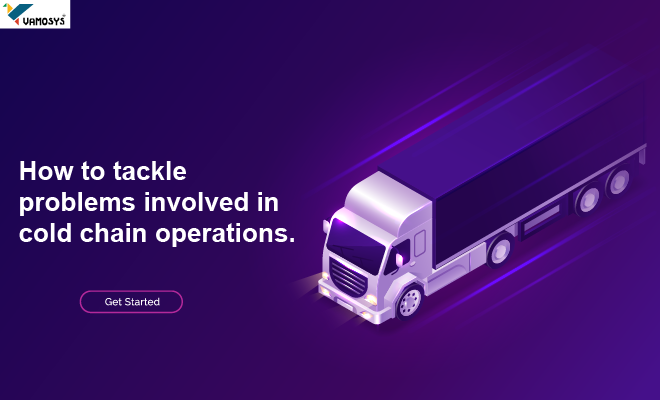How to tackle problems involved in cold chain operations
Summary
The blog discusses the importance of cold chain operations in maintaining the quality of perishable goods during transportation. It explains the various processes involved in cold chain operations, such as HVAC fleets, sensors, and monitoring systems, and highlights the risks associated with improper infrastructure, increased regulations, and human error. The blog also suggests ways to tackle these risks and ensure end-to-end integrity in cold chain logistics for a successful trade.
Quality matters a lot more than quantity, especially in logistics, irrespective of what the quantity is, quality of the products is the most important aspect of a successful business. The goods transported from its origin to its destination must have the same quality maintained throughout the journey. And for that, the temperature maintenance of the goods is the key factor which is achieved through cold chain operations. Here we have the various problems involved in cold chain operations and how they are being controlled to ensure a quality trade.

Purpose of cold chain transportation
Not all goods can be transported under normal conditions. Vegetables, fruits, frozen foods and life saving medicines hold a particular temperature at which they remain quality for use, if not maintained at specific conditions, they get spoiled and cannot be used. To avoid such wastage and ensure the quality of such goods through maintaining its parameters, a special supply chain in the field of transportation is called as the “cold chain operations”.
This cold chain transportation involves various processes involved in it to achieve its target. From the point of loading the goods into the vehicle to the point of delivery. How are these products maintained? There are various factors involved in the process which will be discussed below.
Process involved in cold chain operations and transportations
First and foremost HVAC fleets are needed for the cold chain operations. HVAC vehicles are the ones that hold the facility of Heating, Ventilating and Air conditioning (HVAC) systems embedded within the vehicle through various hardwares and softwares that control the temperature of the products.
There are various types of sensors involved in maintaining the temperature like Accelerometers, optical sensors, pressure sensors based on MEMS, magnetic sensors (Magnetometers, Hall ICs), color sensors, etc. All these sensors along with other processors and microcontrollers comprehensively ensure that the temperature of the product remains constant throughout the transport from its origin to its destination.
Accelerometer helps in detecting the physical conditions of the object like angle, motion, acceleration, impact, etc. In case of any movement or the vibrations, accelerometers detect it.
Optical sensors are used to detect the intensity of light around the product that might impact the temperature. Pressure sensors detect the changes in pressure due to varying altitudes.
Magnetics sensors like magnetometers act as the e-compass for the tracking systems by detecting the exact position of the object. Change in temperature also causes change in color of the products. To detect such changes, RGB color sensors used to indicate the changes in color if there is any.
In addition to these, USB connectors are available to access the date anytime. All these sensors are connected to a data logger that holds all the information of the product digitally. And such information can be regularly monitored through live tracking devices introduced by Telematics to avoid any abnormality in the maintenance.
The initial process involved in cold chain operations is to examine the type of product to be transported and its demands for safe transportation. Then the packing of products or in other words its the load integrity. This involves the safe packaging of the products and loading it into the vehicle.
And then the demand for the products. The temperature at which the product has to be maintained. The conditions are set and verified as per the demand of the product after loading the products inside the vehicle.
And during the transportation, continuous monitoring of the product’s temperature is a key to ensure the safety of the products. In case of any abnormality caused, sensors detect it, detected information is observed by the technical crew through Telematics services and alerts the driver to reset the conditions as per the requirement.
And finally when the products are delivered, temperature and quality of the products are to be checked and the quality assurance has to be given to the client which is one of the most important processes involved in cold chain operations.
Further let us see the various risks involved in the process and the ways to tackle them for better logistics.
7 Risks involved in Cold chain operations and how to tackle them
1.Improper Infrastructure
Infrastructure in cold chain operations has been a major concern in maintaining the quality of the products. As the infrastructure and its conditions differ from place to place. Such variations in the conditions is contradictory to the very basics of cold chain operations which is the consistency in maintaining the temperature of the products.
Such non-uniform infrastructure is the biggest concern for the companies running internations operations where the products are to be transferred, stored and transported through various stages in between the origin and destination point.
The best way to avoid the quality loss through improper or non-uniform infrastructure is by effective temperature monitoring.
And irrespective of the distance and time, end to end integrity must be ensured for the quality trade.
2.Increased Regulations
Cold chain operations across borders have different types of regulations. To ensure safe and faster movement, the company should have proper documentation for clearance.
Poor documentation will lead to delay in clearance which would affect the trade and increase the waiting time for the client.
Apart from documentation, the management should be updated with their knowledge on various regulations that keep changing depending upon the political, socio-economic trends, climatic and environmental conditions.
If the management is not proactive in updating the diversity of regulations, it would be difficult to achieve smooth regulations during the cold chain operations across borders.
Considering global warming, regulations on emission levels are also a major concern for the cold chain operations as the HVAC fleets emit greenhouse gases like Hydrofluorocarbons (HFCs) that are harmful for the atmosphere and also such emissions increase the enforcement hurdles across the national borders.
Customs clearance in case of shipment is a very big concern for companies that run cold chain operations globally in case of its strict rules and regulations. Any improper documentation or improper packing like tears or deants in the packaging would affect the clearance.
Pending dues will also affect the regulations while shipment which will affect the timing and quality of the products too if delayed too much in customs clearance.
3.Environmental Impact
Issues related to the environment is one of the major concerns for the companies and the regulators as supply chain has a huge impact on the environment that include waste deposits which are toxic in nature that reduces the fertility of the soil leading to deforestation. Wastage has to be reduced and proper waste management systems have to be implemented to avoid environmental pollution.
Emission of hazardous gases including the greenhouse gases affects the atmosphere. Companies should plan on effective transportation to reduce the distance and emission levels.
All types of such pollutants and waste generations are to be discussed with the suppliers and companies should have a consistent assessment on their suppliers regarding their emission levels, usage of resources and waste generations.
Importance of sustainability must be understood by all those related to logistical business for a better ecological balance.
Environmental risks also involve socio economic, political, governmental issues like strikes, environmental issues like floods, landslides that might affect the various aspects of the supply chain.
4.Distribution, supplier and delivery risks
As it is the chain of suppliers involved in the process, a contract with good suppliers is a much needed one for quality output. Packaging of the products at the origin point must be done very carefully under appropriate temperature conditions required for the product for a safe supply.
Quality analysis of the product or the raw material is very important before packing it. As packaging is the first step in the supply chain, a good beginning will definitely lead to a good ending.
Distribution process involves the movement of the vehicles and also the storage of the products or in other words warehousing.There are various risks involved with the mobility of the products like hardware failure, modal failure, etc.
Lack of proper analysis and maintenance would result in such failures. Hence the fleets and hardware performances are to be checked thoroughly before the operations to avoid such malfunctions during the operations.
Warehousing is a key factor for cold chain operations as the products in cold chain are very much sensitive to temperature. In case of shipments in harbours and airports, not all have the proper warehousing facility that can provide appropriate temperature for the storage of goods.
5.Security Risks
Security of temperature sensitive products are very important as they cannot be retrieved in the same quality once they are lost. For example Pharmaceutical drugs are very important products for society as they save lives and they are very much sensitive to varying temperatures. Security of such products is important; it can be achieved effectively through tracking devices of Telematic and IOT (Internet Over Things) services.
Telematics and IOT in logistics are a blessing as they solve various risk factors in the logistics business like, live tracking for the security related issues, fuel monitoring to avoid fuel wastage, temperature monitoring for the cold chain operations.
Telematics and IOT enables the management to have complete control over the every movement of the fleet and its current status. Such applications in logistics have made the business very much secure and reliable.
6.Customer demand risks
Cold chain supply is generally a fast moving supply chain inorder to ensure the safety of the products during transportation. Sudden increase and decrease in the demand of the products has its own risk factors.
If the demand rises suddenly, a huge quantity of the products have to be transported. More the quantity, more the risk of management as the products of cold chains are very much sensitive to temperatures. In case of any malfunctions in the maintenance system, the company might face heavy loss.
In case of huge demand, storage is also a major issue for such products. For example, few medicines are supposed to be maintained under very adverse conditions like temperature of less than -50 degrees. In such cases the storage of such a huge quantity of product under such conditions is a risky factor.
If there is a low demand, again the products that were manufactured cannot be thrown away which would be of loss to the producer. So it has to be stored until it meets the demand, hence the storage is the major risk factor in case of varying demand.
7.Human errors
Some of the major human errors in the supply chain are caused due to carelessness, irresponsible behavior and lack of knowledge.
Staff working for your company cannot be careless of anything that is related to fleet operations, especially with the cold chain operations that are very sensitive. A simple mistake can result in heavy loss for the company.
For example, movement of temperature sensitive products from the trucks to the storage points, trucks to airplanes, trucks to ships, etc. These small movements of products make changes in the temperature of the products that eventually affects the quality of products like fruits and vaccines that are very sensitive to the varying temperatures.
And also the lack of knowledge and inefficiency to handle equipment, poor communication skills are also the major risks factors involved in the supply chain. With various advancements in the technology and modes of communication, the staff and workers must be guided, motivated and trained professionally to ensure a better business.
Covid 19 and vaccine transportation
During the covid 19 pandemic, cold chain operations have been the life saving services for humanity. The vaccines that were discovered for the treatment of covid-19 are very much sensitive to its temperature, vibrations and shock.
Understanding these three factors in depth is very much essential for the proper transportation of such a highly sensitive product in the supply chain. Covid vaccines are so sensitive to temperature that they have to be maintained less than -60 degrees celsius.
Before packing the vaccines, the temperature conditions and the quality of the vaccines are to be tested by the concerned quality analysts for the safe transportation. There is no use in packaging and transportation of spoiled vaccines which might result in adverse events.
For such high sensitive products, proper examination before the packaging is a must under appropriate temperature conditions. And once the packing is done, the storage area should also be maintained with perfect conditions. For covid vaccines, it is stored and transported with dry ice that maintains the required temperature for the vaccine.
Any small changes in the temperature would change the characteristics of the vaccine or it becomes useless for the treatment which would result in heavy loss for the society.
Apart from temperature, shock and vibrations are two other factors that are to be focused and understood in depth for a safer supply of covid-19 vaccines.
During the transportation of these vaccines, continuous vibrations of the vaccines must be avoided. Such repetitive low amplitude impacts can be a source of energy to the three dimensional molecules that can alter its chemical properties, Which can result in unexpected results when it is used for the treatment of covid-19.
In case of shock, a shock can happen when there is an impact with the vaccine suddenly like a sudden break or a jerk that can create a high amplitude impact of short duration, resulting in the breakdown of its molecules and reducing its efficiency or effectiveness.
Considering these high risk factors during the transit time, the regulations and transport validations of these vaccines are at high tech. Evolution of technology has helped drastically in validating covid-19 vaccines at the time of delivery.
A transport simulation study can identify if there are any changes in the physical and chemical form of the vaccines that can be caused by the various potential hazards like temperature, vibration and shock. There are two other factors too that can affect the properties of vaccines like pressure and humidity.
Hence, the continuous monitoring of the vaccines under various circumstances is a key factor for humanity as these vaccines are a ray of hope for the survival of people across the globe amidst this pandemic.
Sushanthi
Sushanthi is a Content Writer who wishes to be the voice of brands to project their innovative ideas and stories through her writing skills.

